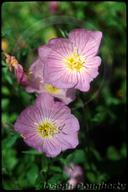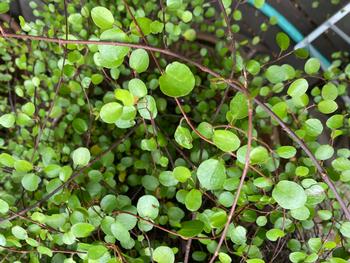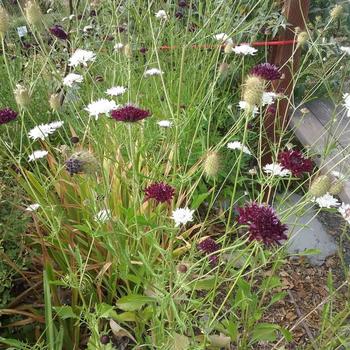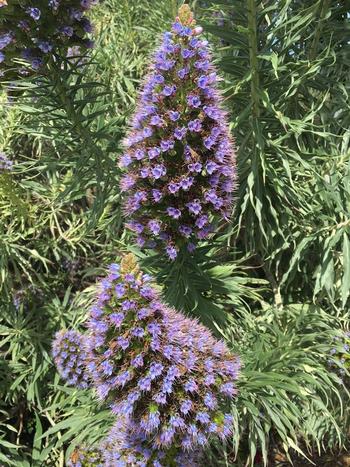Enchanting Plants or Garden Thugs?
How to tell the difference, control measures, resources, and alternatives
by Judy Quan
A Delicate Vine to ID
Question to the Help Desk: Please help me identify this “invasive” vine. It has killed two apple trees. What can I do? It is a vine with tiny round leathery leaves, It attaches to other plants, completely covering and eventually killing the other plant underneath. It sends out roots like ivy and is very hard to cut the vines.
Creeping Wire Vine

The leaves are enchantingly delicate looking, and the purple stems of the vines are twining and the vine has a beautiful trailing habit, able to spill gracefully from a container.
Difficult to Eradicate
I ended up telling the client that the creeping wire vine would be difficult to eradicate and that probably the best she could do for control would be to cut the vines back little by little and she would have to keep doing that to stop the vine from taking over her garden. She said she would be using a box cutter to cut the vines at the base since the vines were so hard to cut.
Creeping Wire Vine Transforms to Garden Thug
With the right climate and growing conditions, some enchanting plants can become garden thugs, taking over entire yards and even spreading to the neighborhood, which is what the creeping wire vine did. This beautiful, lacey groundcover was allowed to grow unchecked for a number of years and became a thug in the garden, climbing and smothering other plants.
The Australian National Botanic Gardens warns that creeping wire vine, native to New Zealand and Australia, spreads relentlessly and can quickly overtake other plants. The vine can be a wonderful groundcover, but it also can become invasive, especially with benign neglect.
Common Garden Thugs … They Are Coming to Get You

- Plants often nominated as garden thugs are:
running bamboo, - mint,
- bee balm,
- Vinca major,
- Japanese honeysuckle,
- Creeping fig (Ficus repens)
- Himalayan blackberries,
- Mexican evening primrose,
- Pink jasmine (Jasmine plyanthum)
- Blue Dawn morning glory,
- Ivy (English/Boston/Algerian)
- Alstroemeria,
- the Peruvian lily,
- Arum lily, commonly called white calla lily.
But there are many other potential candidates.
How To Recognize Other Potential Garden Thugs
- Plants that have descriptors such as “fast-growing”, “fills in rapidly”, “grows aggressively”, “vigorous”, “spreads quickly”, “forms dense cover”, “exuberant in habit”, “easy” means “BEWARE” that you should do more research about the plant before you plant it in the ground in your garden. Often they are fast-growing vines and groundcovers.
- Use information from plant tags and container labels. Talk to other local gardeners.
- Investigate what plants are aggressive in your area with similar growing conditions as your garden. Observe gardens in your neighborhood to know how your new plant might behave.
- Be selective in accepting plant gifts from friends. Why do they have so many of that one type of plant? You could be introducing a garden thug into your garden.
Right Place, Right Gardening Style
It is crucial to choose the right place for your fast-growing plants and to choose plants that fit your gardening style. I know a “needs regular pruning to control its rapid growth” is not a plant for me!

Right Plant, Right Watering
Low-water plants, including some California natives, can spread rapidly if they get regular irrigation. California fuchsia, Mexican evening primrose, lantana, the California wild rose (Rosa californica) and even the Santa Barbara daisy, an UC Davis Arboretum All Star, can go out of control if they are overwatered. Debbie Arrington describes many examples in her article, "The Garden Thugs are Coming to Get You"
Garden Thug Control When We Can’t Resist
Sometimes we love plants that have the potential to become garden thugs and we want them in our gardens. Aggressive doesn’t have to mean invasive. Plants can become invasive under ideal growing conditions. If we know how the plants reproduce, we can slow them down and contain them by being vigilant. You may want to closely watch your garden when you introduce new plants. Try walking your gardens daily just for a few minutes, observing the changes. Take out unwanted expansion of the garden thugs when the thugs are small in size and number.
Know-How Plants Spread, Know How to Control Thugs
- Self-Sowing- Plants that spread by self-sowing, the re-seeders, can be controlled by deadheading, preventing the flowers from going to seed. Examples Scabiosa, Mexican Evening Primrose, oregano
- Rhizomes & Stolons - Plants that spread by rhizomes (underground stems) and those that spread by stolons (above ground runners) can be controlled and limited by a physical hardscape such as sidewalks and by cutting them back.
Examples for rhizomes (underground stems): bee balm (Monarda didyma), running bamboo, Bermuda grass, oregano, mint
Examples for stolons (above-ground runners): lamb’s ears (Stachys byzantina), Bermuda grass, Mexican evening primrose, Pink Jasmine, the false strawberry (Duchesnea indicia).
Potentially Invasive Species … in Our Gardens

I found some of the plants on the Cal-IPC inventory in my garden and in the local neighborhood. Some of these plants are great pollinators like the pincushion flower (Scabiosa atropurpurea) and the Pride-of-Madeira (Echium candicans).
Our gardens may contain some potential garden thugs, but careful plant selection and keen observation in our garden will help us keep them under control, staying within their boundaries.
Find alternatives to garden thugs
Plants may be invasive in some regions of California and not invasive in others. This list indicates in what regions of California a plant is considered to be invasive. Plantright.org has great photos of the priority invasive garden plants and the suggested alternative plant.
Resources
Want to learn more?
This blog post is brought to you by the Help Desk of the UC Master Gardeners of Alameda County. Subscribe to our blog!
Have a gardening question? We'll help. You can reach us by:
- Emailing acmg@ucanr.edu. Please include a photo of the problem, if you can, plus your name, phone number, city and a description of the problem.
- Using our online form.
- By phone, during our office hours, 10 am to noon Wednesday and 11 am to 1 pm Thursday: 510-670-5645. At other times, please leave a message and we'll return your call during our office hours.
- In person at our Hayward office, during our office hours, only by appointment.



